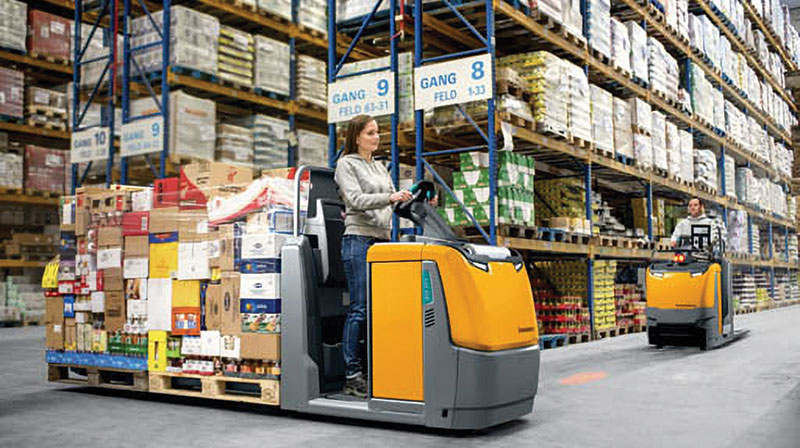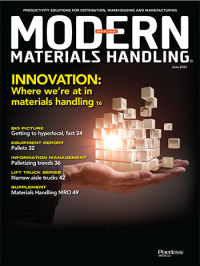Ergonomics, on or off the truck
Today’s lift trucks and standup orderpickers are designed with ergonomics in mind, but new types of wearables are another means of reducing strains and risk of injury for operators.
Plenty of features make operating a lift truck easier and more comfortable, but when operators are off their trucks doing tasks like building an order to a pallet, they should follow proper lifting techniques. And, for all the smarts of today’s lift trucks, they can’t coach the operator on safe techniques.
Wearables with warning features for front-line workers, however, can help operators follow good postures, especially for manual tasks that happen off the truck. Such wearables and the software analytics that come with them detect, analyze and help reduce the risks of injuries for any worker that does a lot of lifting of cases or other goods, says Chris Kuruc, head of product for KINETIC, a vendor of wearable safety technology.
KINETIC’s Reflex wearable is a small device that attaches to a worker’s belt and automatically detects unsafe postures, providing a light vibration warning when improper form is used. The data generated by the wearable feeds into a Cloud-based Web dashboard that provides managers with analytics to improve workplace ergonomics. The alerts, along with goal and reward functions, create new habits and drive sustained behavior change that reduces the chance of injuries, says Kuruc.
“If someone is doing something like lifting with their back instead of their legs, or reaching across themselves in an awkward manner to lift something, the wearable detects these as unsafe postures and provides that real-time haptic feedback to the worker,” says Kuruc. “Those alerts help drive safer postures, while the data analytics will help supervisors or the health and safety manager find opportunities to coach employees to help reduce these risky habits.”
The analytics can also help managers identify areas that could use some changes to layout or materials placement to improve ergonomics. For example, says Kuruc, one company found many unsafe postures were occurring at an area where manual picking was being done from pallets of goods staged next to each other on the floor. Stacking the pallets with just a bit more space between them allowed for easier access for the pickers, which quickly reduced unsafe postures in that area.
“The analytics can help identify tiny little engineering changes that can instantly remove risky postures and behaviors that are going to lead to injuries,” Kuruc says.
One of KINETIC’s users is Iron Mountain, a company whose services include records and document management and shredding. When Iron Mountain outfitted some of its delivery van and truck drivers with Reflex wearables, there was a 64% year-over-year reduction in OSHA recordable injuries for the workers compared to the year before the wearables were in use.
Soter Analytics is another vendor with safety-focused wearable tech. Kenco Logistics, a leading third-party logistics provider, ran a pilot program with Soter’s wearables, and found the technology led to a 22% reduction of hazardous movements by Kenco associates.
Lift truck ergonomics have improved over the years, and some of these same features also improve productivity, says Ryan Crochet, manager of product marketing and financial merchandising for the Houston region of Mitsubishi Logisnext Americas. Features like fingertip hydraulic controls, full suspension seats, padded floors and suspension platforms with switches to easily adjust the suspension level, have been incorporated into various truck models, Crochet explains.
For example, vehicles used for order picking have low floor heights and a cabin design that make it easy to get on or off to either side, which makes work movements easier on the operator, but also contributes to productivity in that operators can more quickly access goods on either side of an aisle. Additionally, semi-automated orderpicker models with remote control can automatically follow an operator picking orders on foot, eliminating the on/off movement entirely, allowing the operator to focus on the order build tasks.

“Improved ergonomics can absolutely help with productivity, because some features like being able to get on or off a vehicle easily make tasks more convenient and faster,” says Crochet. “There are other ergonomic features are that are more about comfort, and although these have a more indirect tie with productivity, ultimately, a comfortable operator is going to be a more productive operator.”

Article Topics
Lift Truck Tips News & Resources
Overlooked no more: The importance of lift truck inspections Lithium transition: It’s all about the outcomes Safety for automatic guided vehicle (AGV) environments Assessing the move to lithium Leasing’s fleet management upside Managing for lift truck operator safety Narrow aisle success: Think systems, then trucks More Lift Truck TipsLatest in Materials Handling
Registration open for Pack Expo International 2024 Walmart chooses Swisslog AS/RS and software for third milk processing facility NetLogistik partners with Vuzix subsidiary Moviynt to offer mobility solutions for warehouses Materials Handling Robotics: The new world of heterogeneous robotic integration BSLBATT is looking for new distributors and resellers worldwide Lucas Watson appointed CSO for Körber’s Parcel Logistics business in North America Hyster recognizes Dealers of Distinction for 2023 More Materials HandlingAbout the Author
Subscribe to Materials Handling Magazine

Find out what the world's most innovative companies are doing to improve productivity in their plants and distribution centers.
Start your FREE subscription today.
April 2024 Modern Materials Handling

Latest Resources












